“Work is the curse of the drinking class.” – Oscar Wilde
I’m often asked why I paint so many drink paintings, and the answer, of course, comes in the form of a story. Just a quick disclaimer, I never set out to paint cocktail paintings, but here is the story of how I got into painting them.
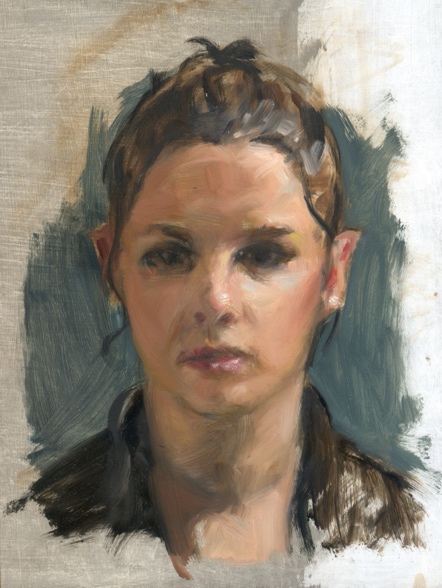 [1]
[1]I studied at the Art Students League part-time and also at the Water Street Atelier over a four year period, 2007–10. Most atelier programs focus on the portrait and figure as the highest level to achieve, and that was my focus. At the League, I studied with Max Ginsburg over many summers, painting the portraits and figures. At the Water Street Atelier, I’d do the same but began by drawing the cast for a year before getting into painting.
In March of 2010 after about four years of intense focus, my heart told me that it had enough, and I left the school setting to enter the forest on my own path. It was time to take all the knowledge I had attained and apply it to paintings that I wanted to make for myself. The problem was, I didn’t know what kind of paintings I wanted to make yet.
At the time, my wife and brother both worked at Ralph Lauren, and there was a position open for me to work as a freelance graphic designer. So, having to pay bills and such, I took a freelance job and worked at RL during the day. My pursuit of being a painter would have to move to nights and weekends while I figured out what to paint. And that’s exactly what I did.
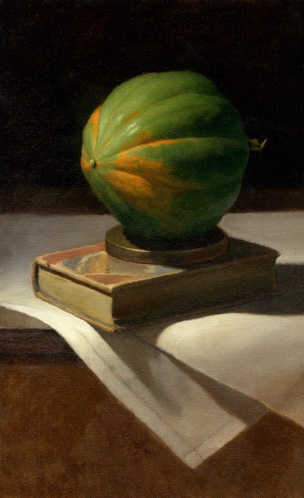 [2]
[2]The routine was that my wife and I would commute home from Manhattan and get to the apartment around 7 p.m. (Forest Hills, Queens). We’d eat dinner and then unwind, watching a little TV. She’d go to bed at around 9 p.m. and that’s when I’d set off for the studio. What this really meant was I’d walk over to the corner of our junior one-bedroom apartment where “the studio” was. (It was really just one room.) I was relegated to paint at night, so I could not hire models to come to my apartment, (Technically, I could have, but it would have been weird.) I decided to try to paint a still life because it was about the only thing I could do at that time, and I wanted to paint from life. But of course, the question arose, What should I paint?
I was searching for my voice and decided to start with simple objects, a still life. I began by just arranging objects in my studio into an order and painted what was in front of me. Of course, many questions began to arise as I studied the objects. What is all of this really? Why am I painting objects? What am I trying to say with this painting? Does all art have to have a meaning? It almost felt like I was having an existential crisis, but I was pondering what to paint and why.
I was also reading a lot of inspirational art books like The Art Sprit[3] by Robert Henri and On Painting[4] by Charles Hawthorne. Both books offer inspiration. I found a few passages that would help me on this long journey of finding something meaningful to paint. Charles Hawthorne says, “If you are not going to get a thrill, how can you give someone else one? You must feel the beauty of the thing before you start.” So, what should I paint hung over me like a bad hangover.
Emil Carlsen, the prominent still life and landscape painter, said,
“Still life painting is considered of small importance in the Art schools, both here and abroad, the usual course being drawing from the antique, the nude, and painting from the draped figure and from the nude. This covers everything for the artists in the growing, but little stress is put upon the student’s individuality. It is routine work from the beginning to end, and often made a bore to the pupil, instead of a delight. Then why should the earnest student overlook the simplest and most thorough way of acquiring all the knowledge of the craft of painting and drawing, the studying of inanimate objects, still life painting, the very surest road to absolute mastery over all technical difficulties. Once learned it applies to all painting, all drawing, and then is the time to study from the nude, and last of all from the Greek masterpieces.”1[5]Palette and Bench, October 1908, p. 6–8
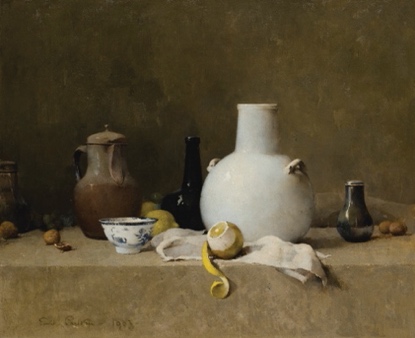 [6]
[6]One of the things I tried to avoid was painting the usual flower with pot and fruit still life. To me, this can get rather boring as it’s been done so many times. So, I channeled the idea of the purple cow from Seth Goden. This was a concept that if you drove on a street or highway and saw some cows, you would not stop. If you saw a purple cow, you’d stop and see why it’s purple. The idea was to make your painting a purple cow. (This was taught to me by the artist Thomas Fluharty[7].)
I’m sure the big idea to paint cocktails came while having a drink with a friend or family member and perhaps the drink was placed in the living room/dining room/studio. That I can’t remember, but it sounds romantic to say that’s what happened. So my big idea was, Instead of flower pots with fruit, I’ll paint cocktails with a fruit/garnish. How genius, I thought!
 [8]
[8]Cocktails almost always come with a garnish of a fruit or vegetable, plus they have designated glassware. Add in a colored napkin and the work can have a contemporary flare to it. This would be the small twist I needed. I also love a good narrative in a painting. The beauty of this genre is that there are endless cocktails. At the time, mixology was taking off and Mad Men was a number one hit show.
The first cocktail I painted was my favorite drink, the Sidecar. A good friend turned me onto these when I first move to NYC, around 2002. I brought the painting to the gallery that represents me, Rehs Contemporary Galleries[9], and they sold it the first week. So, there it was, the birth of the cocktail painter. Since then, I’ve done nearly 100 cocktail paintings and nearly all of them have sold.
In 2018, I had the opportunity to write The Art of Still Life[10] with Monacelli Press. I was assigned an editor, James Waller, to clean up the text. We chatted nearly every week about a chapter, so we got to know each other really well. When working on editing my book, he mentioned a few things when he saw my cocktail paintings, and we got to talking about his book, Drinkology[11], which sold about 70,000 copies. I asked James if he’d be interested in doing a cocktail painting book with recipes, and he thought it was a great idea. When The Art of Still Life was complete, we began planning a cocktail and recipe book.
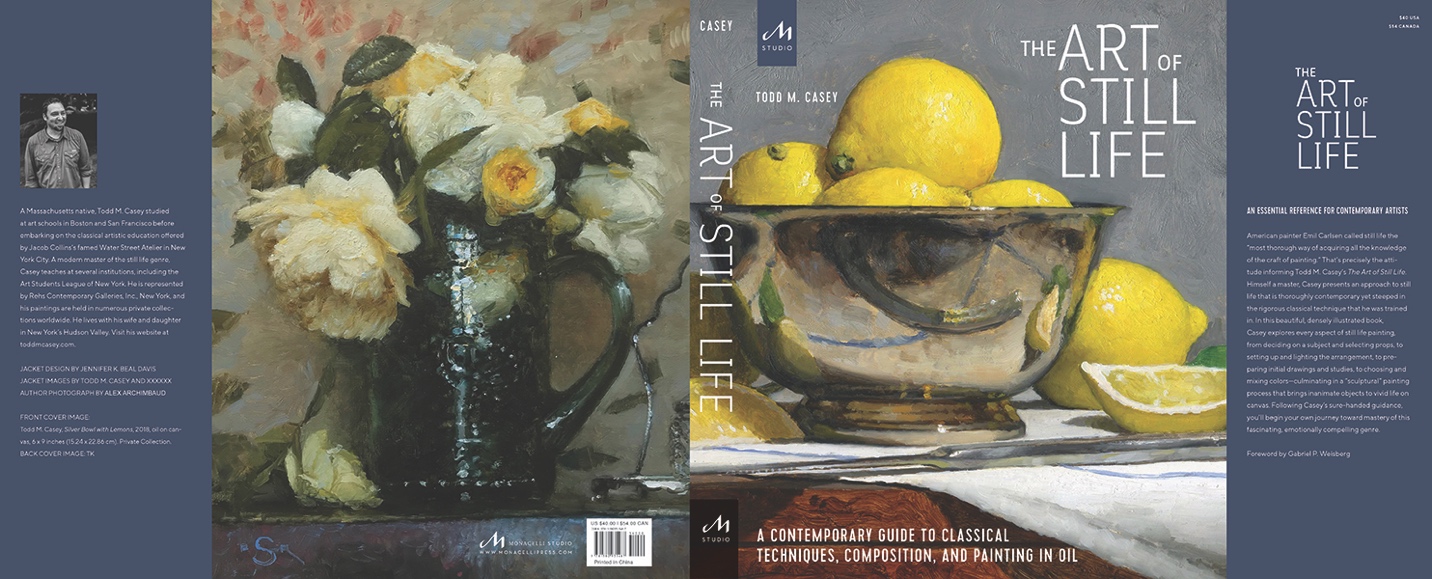 [12]
[12]We decided to bring in another expert writer to help with the book, Christine Sismondo. The three of us put our proposal together, and we hired an agent to shop to different publishers. Shortly after, it was picked up by Running Press in 2020.
 [13]
[13]I’m hardly the first artist to have a cocktail in the painting, or as the subject of a painting. The Dutch always painted extravagant scenes of food and wine in their paintings. They used the objects in their painting as a form of symbolism suggesting big concepts like the mortality of man/woman (skulls). The Roemer glass (wine glass) is commonly seen in many of their paintings almost always half full (or half empty, you pick).
Fast forward to the late twentieth century and artists such as Edgar Degas, Edouard Manet, and Vincent van Gogh (among many others) did many paintings of absinthe. This was referred to as ”la fee verte” or “the green fairy” supposedly because you’d hear a whisper from a fairy as you drank the wormwood concoction. Here is an excerpt from the book about this mysterious green drink:
“A long time ago, happy hour used to be green. During la Belle Epoque, l’heure verte (the green hour) saw the café’s of Paris filled up with artists, writers, and scenesters officially calling it a day with a glass or two of absinthe.
Originally, a medicine created in Switzerland by the preposterously misnamed Dr. Ordinaire, absinthe rose to popularity in the second half of the nineteenth century, particularly in France, which at the time was experiencing a wine shortage thanks to the phylloxera louse, which loves to eat grapevines. Unfortunately, absinthe became too popular for its own good. As people got carried away with it, authorities began to believe (erroneously) that the drink was poisonous. If properly made, it wasn’t. And it still isn’t. But fake news does have a way of confusing people, and, before long, countries around the world started banning the drink. In 1915, even France fell in line and officially put an end to the “green hour.”
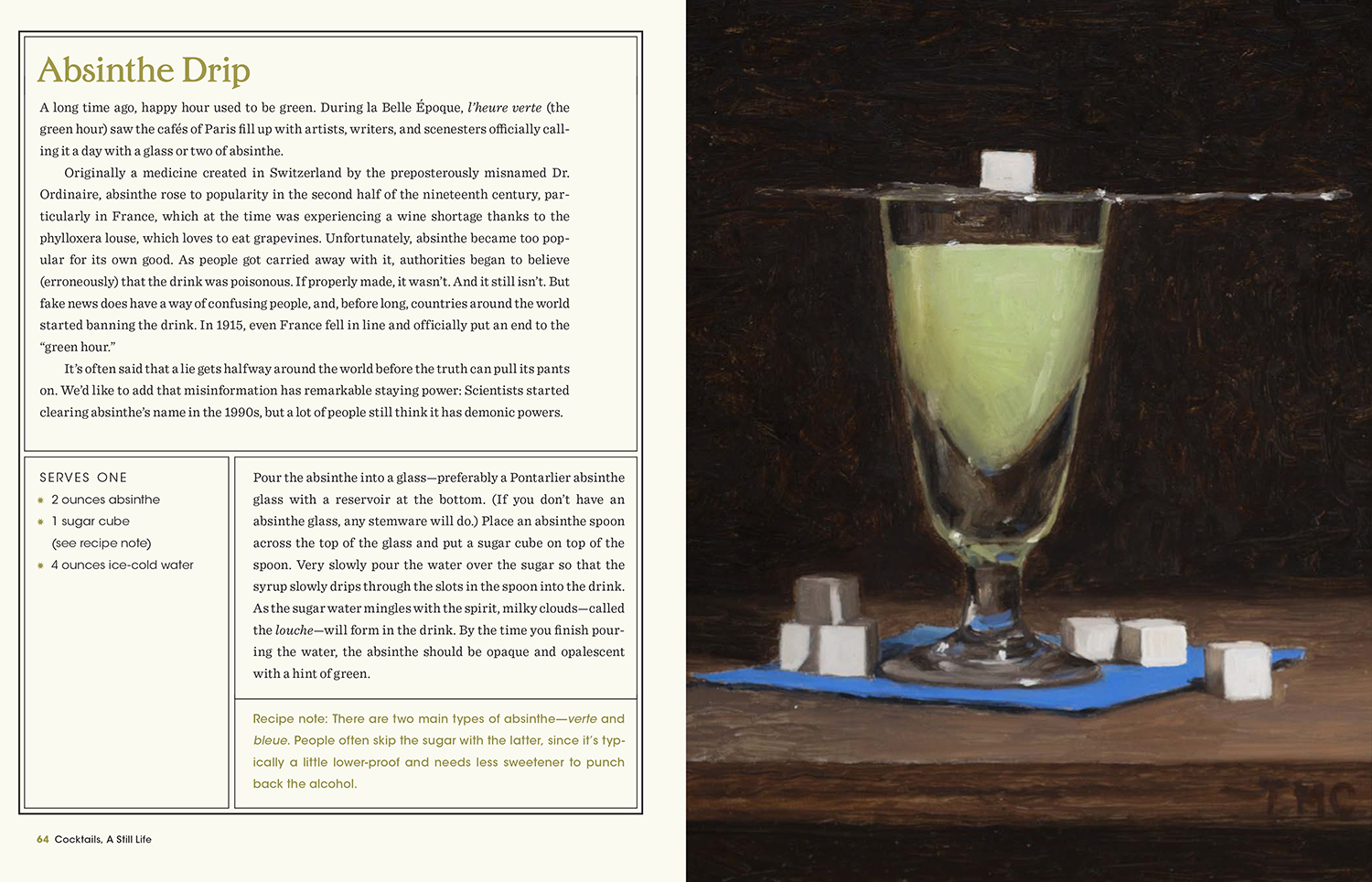 [14]
[14]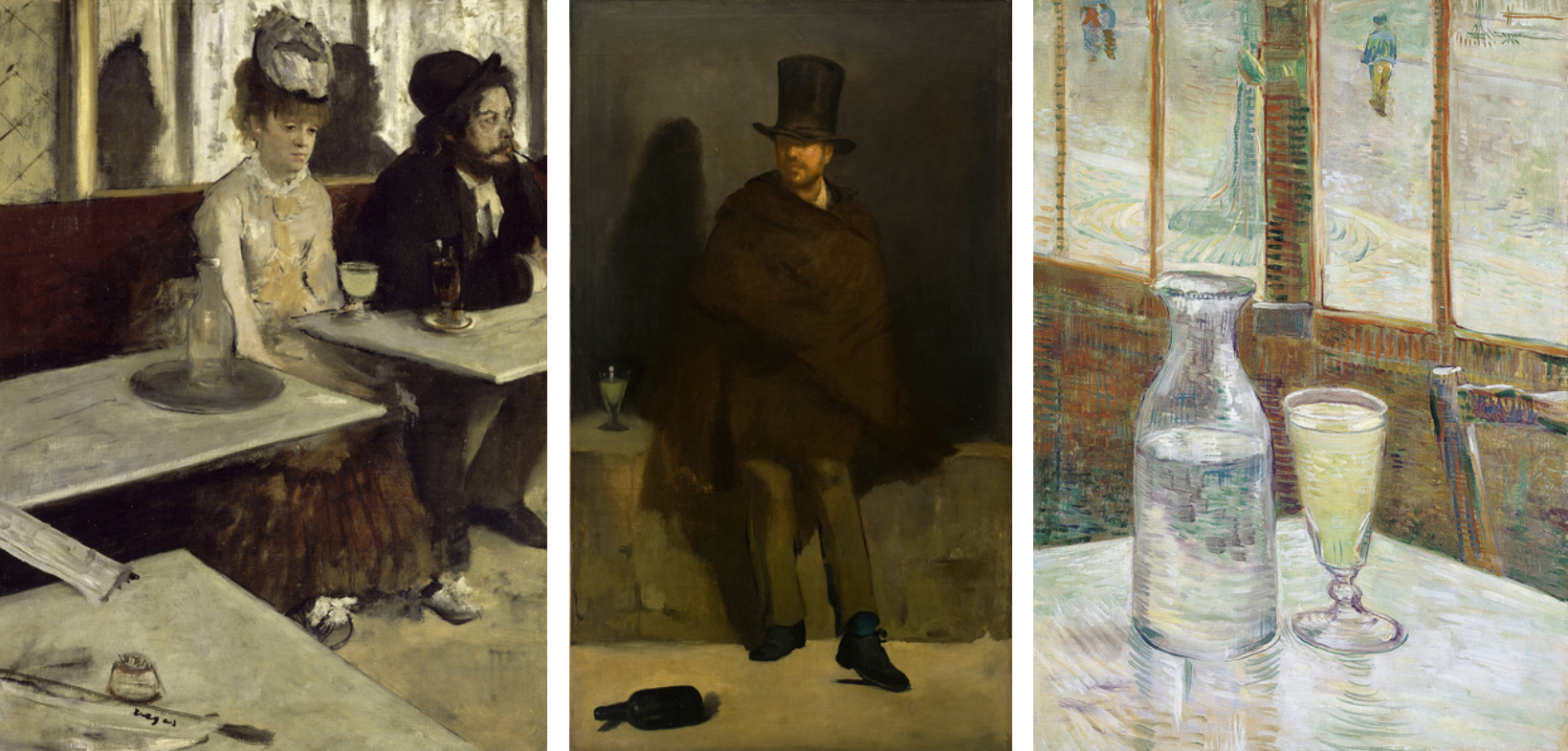 [15]
[15]We finished the book at the end of 2021. It was a lot of fun working on the project. The wonderful thing about this book is that it celebrates the cocktail as fine art. There are sixty recipes, a painting, and some history on each cocktail.
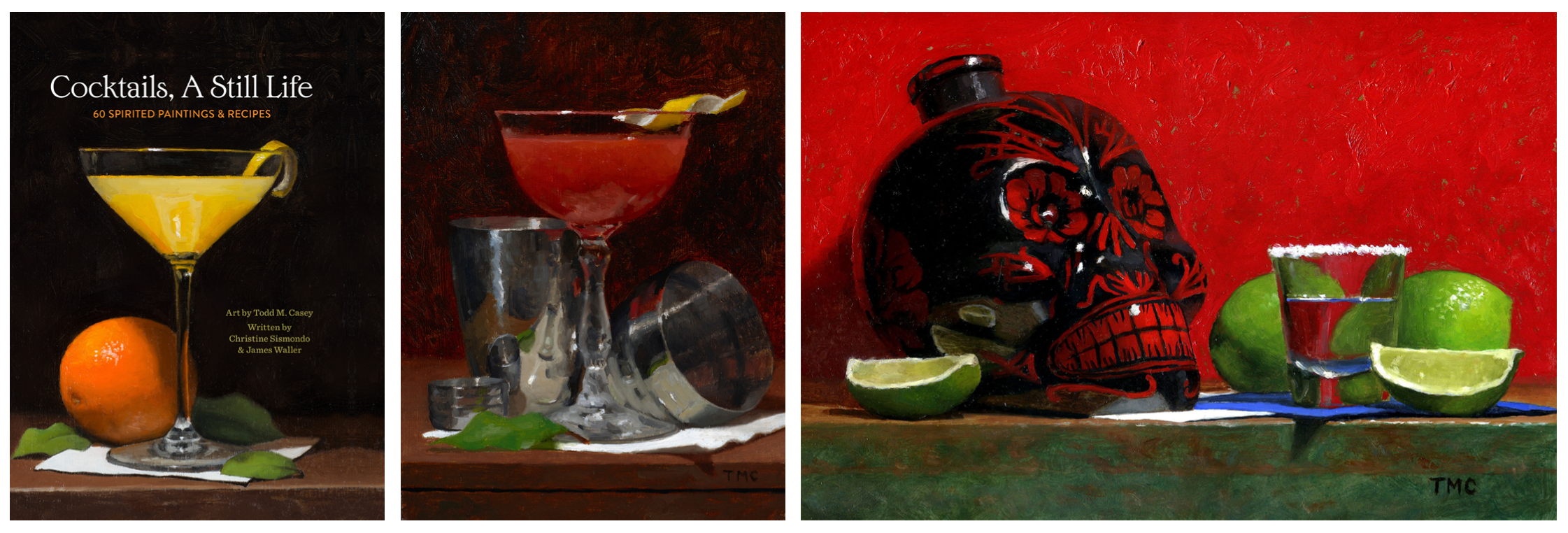 [16]
[16]What started as making meaningful paintings has opened the door to some really fun opportunities. I never set out to be a still life painter or a painter of cocktails, but the subject has opened many doors where perhaps there would have been walls. The release date for the new book is August 16, 2022. The book is in pre-order in all major bookstores.
This fall, there will be a show and book signing at Rehs Contemporary Gallery[17] in Midtown to celebrate the release of the book. Come celebrate the cocktail, as a still life. Cheers, Todd M. Casey.
 [18]
[18]- [Image]: https://asllinea.org/wp-content/uploads/2022/04/image1-31.jpeg
- [Image]: https://asllinea.org/wp-content/uploads/2022/04/image2-33.jpeg
- The Art Sprit: https://www.amazon.com/Art-Spirit-Annotated-Illustrations/dp/1732649138/ref=pd_lpo_1?pd_rd_i=1732649138&psc=1
- On Painting: https://www.amazon.com/Hawthorne-Painting-Dover-Art-Instruction/dp/048620653X
- 1:
- [Image]: https://asllinea.org/wp-content/uploads/2022/04/image5-39.jpeg
- Thomas Fluharty: http://www.thomasfluharty.com/
- [Image]: https://asllinea.org/wp-content/uploads/2022/04/Sidecar_Study.jpg
- Rehs Contemporary Galleries: https://rehs.com/eng/contemporary-front-page-2/
- The Art of Still Life: https://www.monacellipress.com/book/still-life-painting/
- Drinkology: https://www.amazon.com/Drinkology-Revised-Updated-Science-Cocktail/dp/1584798289
- [Image]: https://asllinea.org/wp-content/uploads/2022/04/image7-43.jpeg
- [Image]: https://asllinea.org/wp-content/uploads/2022/04/Claesz.jpg
- [Image]: https://asllinea.org/wp-content/uploads/2022/04/AbsintheDrip.jpg
- [Image]: https://asllinea.org/wp-content/uploads/2022/04/Screen-Shot-2022-04-12-at-10.35.27-AM-2.png
- [Image]: https://asllinea.org/wp-content/uploads/2022/04/Screen-Shot-2022-04-12-at-10.10.40-AM.png
- Rehs Contemporary Gallery: https://rehs.com/eng/contemporary-front-page-2/
- [Image]: https://asllinea.org/wp-content/uploads/2022/04/Screen-Shot-2022-04-12-at-10.19.42-AM.png